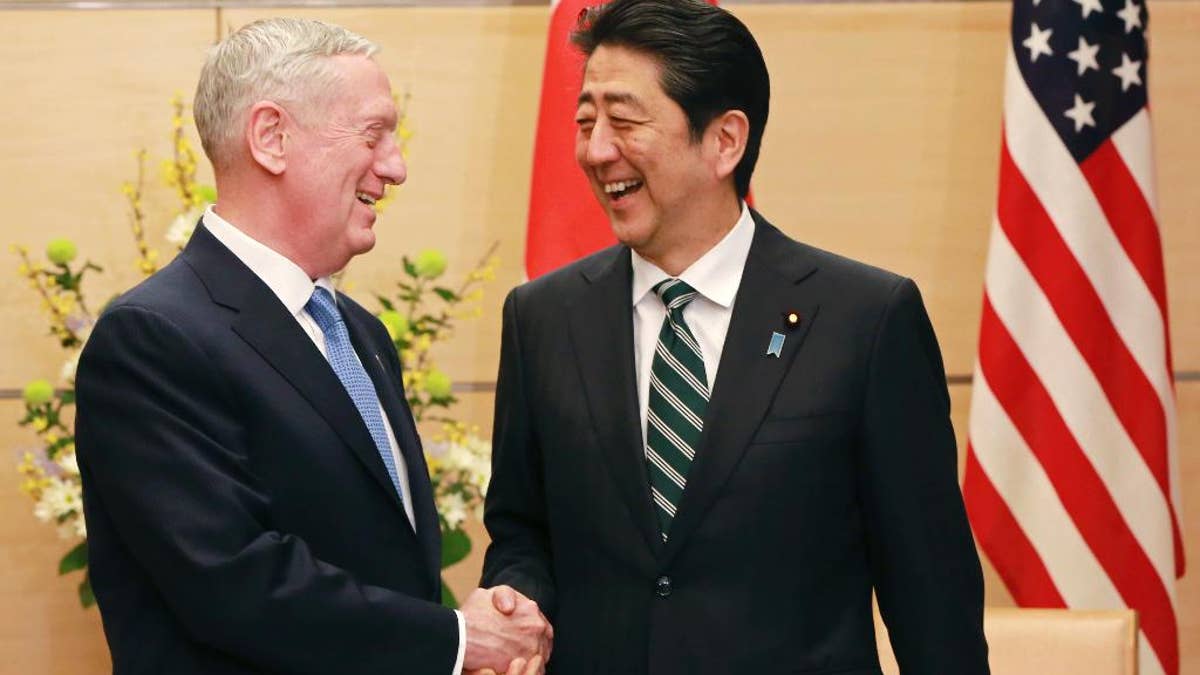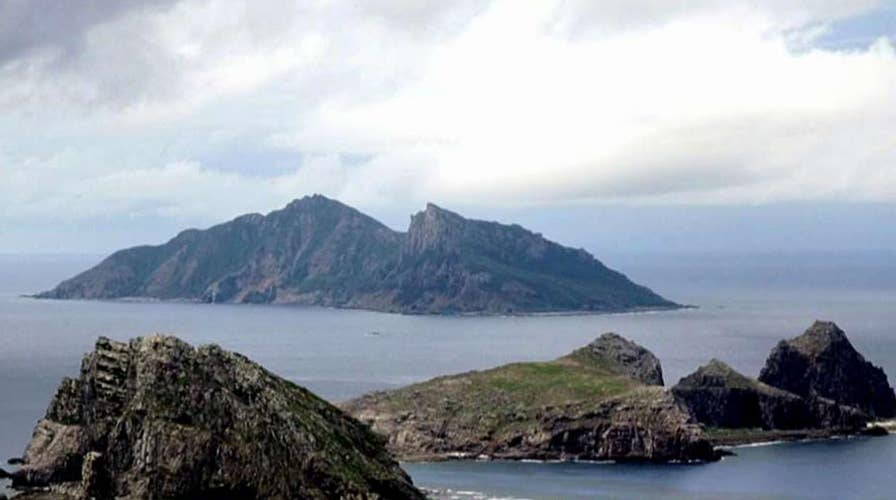China sails warships near disputed islands in East China Sea
Move comes days after Defense Secretary Mattis reaffirmed U.S.'s commitment to defend Japan, including Senkaku islands
Three Chinese warships sailed near the contested Senkaku Islands Monday, apparently sending a message to the U.S. just two days after President Trump’s defense secretary visited Japan and vowed to defend the islands.
STATE-OF-THE-ART CHINESE BALLISTIC MISSILE APPEARS IN MILITARY DRILLS
The ships sailed within Japan’s territorial waters some 12 nautical miles off the islands in the East China Sea, roughly 140 miles northeast of Taiwan, a U.S. defense official told Fox News.

Defense Secretary Jim Mattis, left, with Japanese Prime Minister Shinzo Abe on Friday. (AP Photo/Eugene Hoshiko, Pool)
On his first overseas trip as defense secretary, Jim Mattis, speaking in Tokyo, said China “has shredded the trust” of countries in the region by building up man-made islands in the South China Sea. He also said the U.S. commitment to protect Japanese territory applied to its islands in the East China Sea.
CHINA'S FIRST LARGE HOMEMADE PASSENGER JET TO FLY IN 2017
Mattis later called for all regional disputes over territory to be handled peacefully during a press conference alongside his Japanese counterpart, Minister of Defense Tomomi Inada.
The Chinese, who also lay claim to the Senkakus, call the uninhabited islands the Diaoyus.
Japan has laid claim to the islands since the late 19th-century. China has claimed the islands since the end of World War II.
“I made clear that our long-standing policy on the Senkaku Islands stands. The U.S. will continue to recognize Japanese administration of the islands,” Mattis said. “As such, Article 5 of the U.S.-Japan Security Treaty applies.” Article 5 commits the U.S. to defend Japan or its territories if attacked.
Following Mattis’ pledge, Chinese Foreign Ministry spokesman Lu Kang said, “We urge the U.S. side to take a responsible attitude, stop making wrong remarks... and avoid making the issue more complicated and bringing instability to the regional situation.”
The three Chinese coast guard cutters were Haijing patrol boats with hull numbers 2302, 2305 and 2501, the U.S. official added. Chinese government ships intruded in Japanese waters at least 34 times in 2016, The Japan Times reported.
The sailing of the Chinese warships close to the contested islands followed a series of other recent provocations in the region.
China has flown nuclear-capable bombers around other contested islands, including the Spratly Islands, six times this year. The latest flight took place on Sunday, according to the official.
In late November, China flew a pair of nuclear-capable bombers around Taiwan for the first time.
Days later the Taiwanese president called then-President-elect Donald Trump to congratulate him on his election win. The call broke a decades-long “one-China” protocol with American leaders communicating directly with Beijing only.
Japan scrambled eight F-15 fighter jets to intercept the Chinese flight while it was circumnavigating Taiwan, according to officials.
In recent years, China has constructed seven artificial islands in the South China Sea and has placed runways on three of them. In recent months, China has added military fortifications to protect the islands.
In late December, China placed hundreds of surface-to-air missiles on Hainan Island off mainland China, which intelligence officials say could one day be moved to China’s man-made islands in the South China Sea to better defend them.
President Trump’s newly confirmed secretary of state, Rex Tillerson, told lawmakers during his confirmation hearing last month that China’s buildup in the South China Sea was "akin to Russia’s taking Crimea” from Ukraine.
"We’re going to have to send China a clear signal that, first, the island-building stops and, second, your access to those islands also is not going to be allowed,” he said.
Mattis visited South Korea before arriving in Japan as part of his Asia trip. He also met Japan’s prime minister, Shinzo Abe.
The Associated Press contributed to this report.

